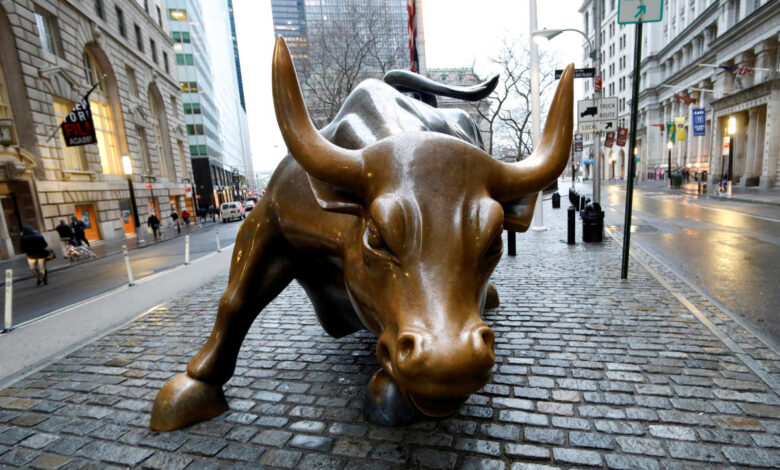
[ad_1]
Investors pushed bank stocks higher last week, riding a stock market rally fueled by hopes that the Federal Reserve might be done raising interest rates and that a “soft landing” in the US economy was now possible.
Last Tuesday, after inflation data showed pricing pressure cooling quicker than expected, two major indexes that track the banking industry had their biggest single-day jumps since May 2020.
These same indexes – KBW Nasdaq US bank index (^BKX) and the KBW Nasdaq US regional bank index (^KRX) – are also on pace to show their best monthly returns in nearly three years. Both have surged roughly 13% since the beginning of November.
But analysts are not yet ready to declare that the worst is over for the industry, cautioning that many banks still face a litany of pressures that are expected to last well into 2024.
Regional banks are certainly on more stable ground than they were during the first half of the year, when the failures of Silicon Valley Bank, Signature Bank and First Republic triggered panic about the strength of many other mid-sized banks across the US.
Yet their ability to earn more robust profits remains a challenge due to elevated interest rates and bond yields that mean more expensive deposits, higher paper losses on bonds held for investment and difficulties for borrowers.
New capital requirements proposed by US regulators threaten to make it even more difficult for some of these mid-sized banks to thrive in the future. Those rules, set to go into effect starting in 2025, are currently the subject of fierce debate in Washington.
Regional bank stocks have notably lagged the S&P 500 this year, even as they’ve recovered from the drubbing they took last spring. In fact, the KBW Nasdaq US bank index and the KBW Nasdaq US regional bank index are still trading at near-record low levels compared to the performance of the S&P 500.
The bull case for banks is that peak interest rates are now in the past and that a recession does not develop in 2024. If the Fed begins cutting rates next year, as many on Wall Street are now projecting, that could lower the industry’s deposit costs and thus improve profitability.
Currently, the Fed funds rate sits in a target range of 5.25%-5.50%, the highest since 2001, following the most aggressive series of hikes since the 1980s.
Some bank bulls point to what happened in 1995, the year following another series of interest rate hikes by the Fed. Once it was clear those hikes were over and the Fed cut rates twice, bank stocks surged by 54% on average that year and at least 37% for the two years following.
‘We’re going to go right back the other way’
But bulls have had their hopes dashed before. Bank stocks also surged in July, once it became clear that deposit outflows at certain regional lenders had stabilized, only to retreat again in September as long-term bond yields surged and fears mounted that the Fed planned to hold rates higher for longer.
“It’s nice to see this rally,” said bank analyst Chris Whalen, but “we’re gonna go right back the other way” when the US Treasury auctions off long-term debt and bond yields rise again.
It is also still possible that financial conditions could tighten significantly, as the Fed’s “higher for longer” interest rate campaign is expected to slow business activity. And if inflation reaccelerates and the Fed is forced to keep raising rates, bank stocks could certainly be in for more trouble.
The vast majority of long-term investors remain underweight banks and they aren’t interested in increasing exposures, said RBC banking analyst Gerard Cassidy.
They are “taking a wait and see attitude and I think they’re going to need to see further evidence that a soft landing is going to show up for them to jump in with both feet,” Cassidy said. A “pivotal moment” will come when the Fed communicates fully that it is done raising rates, he added.
“Once [the Fed] indicates they are done, the next move on rates will be down. If they don’t cut rates dramatically that will be a signal to investors that the economy is going to get a boost.”
David Kostin, chief US equity strategist for Goldman Sachs, highlighted commercial real estate as a known risk heading into next year.
That “will likely imperil several regional banks holding mortgages where the collateral value is below the loan amount,” Kostin wrote in a 2024 outlook published last week.
The Fed, in a bank “supervision and regulation” report released earlier this month, highlighted exposure to commercial real estate deterioration as among the top issues being monitored by bank examiners, along with the impact of rising interest rates on bank capital and earnings.
Some in the industry are still concerned about the amount of unrealized bond losses sitting on bank balance sheets.
Most banks will continue to shoulder those “deadweight” assets, according to Jeff Davis, managing director at Mercer Capital.
“It’s a drag on profitability,” he said.
Unrealized losses on held-to-maturity bonds rose on average by 2.49% in the third quarter as compared to the second, according to SNL data analyzed by Mercer Capital, with mid-sized to regional lenders seeing higher average losses.
These paper losses are forcing many banks to cut back on lending, limit dividends and sell off assets.
“It’s really taken away most banks’ ability to go on offense,” Alexander Yokum, a regional bank analyst with CFRA, told Yahoo Finance.
David Hollerith is a senior reporter for Yahoo Finance covering banking, crypto and other areas in finance.
Click here for in-depth analysis of the latest stock market news and events moving stock prices.
Read the latest financial and business news from Yahoo Finance
Source link




